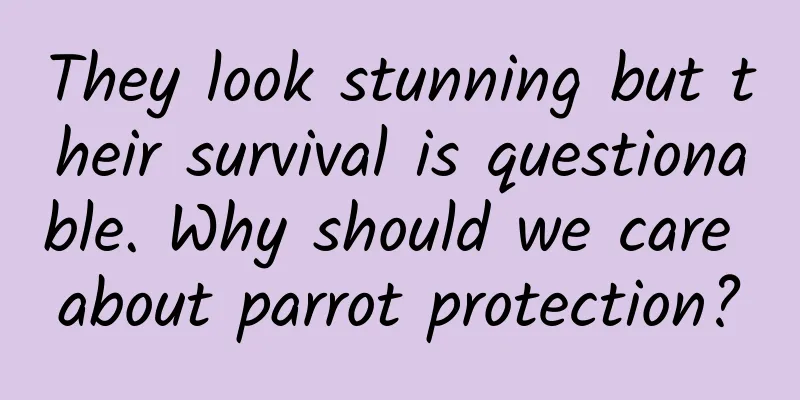They look stunning but their survival is questionable. Why should we care about parrot protection?

|
Produced by: Science Popularization China Author: sky hawk (popular science creator) Producer: China Science Expo Editor's note: In order to decode the latest mysteries of life science, the China Science Popularization Frontier Science Project has launched a series of articles called "New Knowledge of Life", which selects cutting-edge achievements in the field of life science and interprets them in plain language as soon as possible. Let us delve into the world of life and explore infinite possibilities. Parrots are a general term for animals in the order Psittaciformes, a large family with nearly 400 members, and a prominent family in the class Aves. They have bright and eye-catching feathers, lively and active personalities, melodious voices, and are good at imitating human speech, which can be said to accurately hit the aesthetic point of most people! A gathering of parrots, the spirit of birds Even passers-by who don’t know much about birds can easily distinguish parrots from other birds. Parrots have two extremely distinctive features: first, thick and curved beaks that can easily bite hard seeds; second, unlike the 3-foot-long feet of ordinary birds, parrots have 2-foot-long feet at the front and 2-foot-long feet at the back, which can not only grasp things like human hands, but also walk on straight tree trunks and rugged rock walls as if they were flat ground, showing their climbing nature! Several representative parrots (Image source: Wikipedia) Parrots are mostly distributed in the Southern Hemisphere except Antarctica, and a small number are distributed in some subtropical and temperate regions of the Northern Hemisphere. Among them, Oceania and South America have the most abundant parrot species. Global distribution of parrots (Image source: Wikipedia) Parrots can be roughly divided into three major families: the isolated New Zealand parrot superfamily (Strigopoidea), the well-developed cockatoo superfamily (Cacatuoidea), and the most widely distributed and morphologically diverse (true) parrot superfamily (Psittacoidea). New Zealand Parrot (Image source: Wikipedia) Cockatoo (Image source: Wikipedia) Representatives of the superfamily Eupsittacoidea (Image source: Wikipedia) Modern molecular biology research shows that the three major lineages of the parrot family had separated as early as the Late Eocene about 38 million years ago. Divergence time within the order Psittaciformes (Image source: Reference [1]) Although all parrots have the same curved hooked beaks, due to differences in ecological niches, the beaks of parrots from different groups still have subtle or even significant differences. Generally speaking, parrots that are good at eating nuts tend to have thicker, longer and more pointed upper beaks than lower beaks; while various nectar parrots, such as the rainbow lorikeet (Trichoglossus moluccanus), have narrower and more prominent beaks so that they can lick nectar and pollen deep into flowers. Different Types of Parrot Beaks (Photo source: Mynai Edition of "Global Parrot Atlas") Parrots not only have rich and colorful feathers, but also have very different body sizes, which can even be nearly 100 times different. The South American Hyacinth Macaw (Anodorhynchus hyacinthinus) is 1 meter long from head to tail, but it is not the largest or heaviest parrot. The Kakapo, which is unique to New Zealand, is not as long as the Hyacinth Macaw, but weighs 3 kilograms, almost twice as much as the former. In contrast, several species of pygmy parrots (Micropsitta.sp) living on Pacific islands are only 8 to 9 centimeters long and weigh only 10 grams, which is far less than the weight of an egg. Size comparison between the pygmy parrot (left) and the hyacinth macaw (right) (Image credit: Featured Creature/ledbestov) There are many beautiful birds, many of which are male birds with flamboyant appearances, while female birds are simple and homely. However, the appearance of parrots is very balanced, to the point where "how can I tell whether I am male or female?" Even for some zoologists, it is not easy to determine the gender of a parrot just by naked eyes, and sometimes DNA testing is even required. Only a few parrots have such obvious differences in appearance that the male and female can be distinguished at a glance. For example, most parrots in the genus Psittacula.sp have black rings on their necks in males; male budgies (Melopsittacus undulatus) have blue noses, while females have white to brown nostrils. The most thorough distinction between males and females is in the Eclectus roratus, where males are emerald green and females are bright red. Now you can tell who is male and who is female, right? (Image source: Wikipedia) Eco-guard, flagship species Parrots, like other birds, are also a vital part of the ecosystem, playing an especially important role in spreading seeds. Some parrots even establish mutualistic relationships with plants, and their role in seeding is almost irreplaceable. For example, the Hyacinthus macaws mentioned above feed mainly on the seeds of specific palm trees, which are often nuts. The parrots will spread the seeds to new places after eating the pulp. These parrots help the seeds of palm trees germinate and grow by gnawing on the hard fruits. Without the participation of the Hyacinthus macaws, the seed dispersal efficiency of these palm trees will be significantly reduced. Parrots and their symbiotic plants (Image source: Reference [4]) The relationship between parrots and seeding plants is mutually beneficial. Parrots not only affect a series of plant life cycles, but the nutritious fruits also provide parrots with essential energy to maintain physiological activities. On a deeper level, the "seeding behavior" of parrots transforms the distribution and number of plant communities in an area, further shaping the vegetation landscape of the habitat and bringing positive effects to the healthy operation of the ecosystem. Dream Bird, Cultural Sustainment Parrots have a very long history of being kept as pets, dating back to Brazil 5,000 years ago. Parrots first entered the European consciousness in the 3rd century BC, when Alexander the Great conquered ancient India and brought back to Greece the Alexandrine Parrot (Psittacula eupatria), named after himself. Alexandrine Parrot in mosaic (Photo source: Berlin National Museum) The ancient Chinese people started to raise parrots no later than the pre-Qin period. In ancient books, parrots were often called parrot mothers or parrot brothers. With the opening of the Silk Road and the Maritime Silk Road, exchanges with the outside world gradually increased, and some overseas species also entered China unimpeded to meet the "parrot fever" of ancient dignitaries. For example, Song Huizong vividly and realistically depicted a gorgeous honeyeater (Saudareos ornata) tributed from the Indonesian archipelago, which was called a five-color parrot at the time. Huizong was not a good emperor, but he was definitely a good painter (Image source: wiki) In the cultural field, there is also the famous Longshan Parrot, whose image frequently appeared in the writings of literati from the Han Dynasty to the Tang and Song Dynasties. In the Southern Song Dynasty, because Longshan, located at the junction of Shaanxi and Gansu, was no longer Song territory, the Longshan Parrot was no longer just a rare bird that could talk, but also a symbol of lost territory. There is a saying that the Great Purple-breasted Parrot (Psittacula derbiana) is what the ancients called the Longshan Parrot. (Image source: Wikipedia) Survival: mixed fortunes Currently, about 30% of the world's parrot species are threatened by habitat loss and illegal trade, especially the pet trade. The artificial breeding technology of some medium and large parrots is not mature enough to meet the market demand of "self-sufficiency" and "self-production and self-sales", and they still need to capture wild individuals to supplement. Secondly, the vast majority of parrots have been artificially bred for a short period of time, and have not yet produced artificial color lines that are completely different from those of wild individuals. There is a risk of breeding farms "whitewashing" wild individuals. African grey parrots are at risk of pet trade (Image source: The dodo) Some species of parrots are even critically endangered, such as the blue macaw (Cyanopsitta spixii), the prototype of Rio, which was once extinct in the wild. In 2000, when the artificial population was at its most dangerous, there were only 60 left. After more than 20 years of efforts, on June 11, 2022, the first batch of 8 blue macaws were successfully released into the wild. The first batch of released blue macaws (Photo source: CBC) On the other hand, some parrots have taken advantage of the pet trade to spread to other places through pet abandonment and escape. Some have successfully integrated into the local natural environment and become naturalized species, making other places their home, such as the peach-faced cockatoo in Arizona and the small sunflower-crested cockatoo in Hong Kong. Wild peach-faced peony in Phoenix (Image source: AZcentral) Others, such as the monk parakeet, which is native to South America, have been introduced to many North American and Western European countries. They have strong adaptability, and they are mainly plant-eating, but sometimes they also eat carcasses and insects. Unlike other parrots that only use natural tree holes and rock caves, monk parakeets use various materials to build their own nests. They also love to make their homes on urban electric poles, and they often join together to build a large nest, which causes serious problems for the power transmission of the electric poles and the safety of residents. In addition, their strong appetite also has a lot of impact on local crops, and farmers regard them as pests. Monk parakeets nesting on telephone poles (Image source: Your Observer) References: 1.Phylogenomic Analysis of the Parrots of the World Distinguishes Artifactual from Biological Sources of Gene Tree Discordance. 2. Witmer, MC; Cheke, AS (May 1991). "The Dodo and the Tambalacoque Tree: An Obligate Mutualism Reconsidered". Oikos. 61 (1): 133–137. 3. Dr. Roger Lederer (2020) A Brief History of Parrots 4. Blanco, G., Hiraldo, F., Rojas, A., Dénes, FV, and Tella, JL (2015). Parrots as key multilinkers in ecosystem structure and functioning. Ecology and Evolution 5, 4141–4160. 5.Dr. Roger Lederer (2020) A Brief History of Parrots 6. Liu Wenfei, A Study on the Distribution and Changes of Parrots in Ancient China (2010) 7. [Encyclopedia Knowledge] Liu Xiaofang, From the Palace God Bird to the Balcony Pet - Travels of the Parrot 8. Wikipedia related content (Note: Latin text should be italicized.) |
<<: From the streets to the Olympics, skateboarding should be seen!
Recommend
How much does it cost to customize a book mini program in Honghe?
The factors that affect the quotation for the cus...
Silent mutations: a way to conquer cancer?
On the road of scientific exploration, it is ofte...
Xiaomi is actually the second largest wearable device company. Who is the first?
According to the latest report from market resear...
Wonders of the universe: Does the gold on Earth come from the crazy neutron star "alchemy"?
There is a fable called "Sun Mountain"....
The 5nm process is about to be launched. Will it be the killer feature of iPhone 12?
The MWC at the end of February has been cancelled...
[Creative Cultivation Program] Geothermal Energy Exploitation: Digging deep into the earth to get thermal energy, is it reliable?
Author: Niu Mingmin Reviewed by: Zhang Yuxiu, Pro...
China Automobile Dealers Association: Interpretation of the 2022 Chinese Automobile Brand Competitiveness Research
The data for this brand comprehensive competitive...
All mobile phones are equipped with AI, but why do you disdain it?
Watch any mobile phone launch event and you will ...
OPPO K9 Pro mobile phone review: hot appearance and cool core, a great value "light flagship" choice
Today's mobile phone market has fallen into a...
“I discovered it!” Darwin and Einstein also “competing for the first place”?
Text| Shi Xiaolei The third issue of Physics maga...
Wang Fang's "Crossing the Historical Line and Understanding the Small Ancient Chinese Literature" is available for free download on Baidu Netdisk
Wang Fang's "Crossing the Historical Lin...
First look at the project
Open VS2015, create a Web project, select ASP.NET...
Apple makes an exception and allows employees to take unreleased prototypes home. The new iPhone is made entirely by remote control
During the COVID-19 pandemic, Apple made an excep...
Operators take action: Is the nightmare of router manufacturers coming?
Smart routers are an entrance, and the giants are...
Competitive product analysis: Pinduoduo and Taobao's money-saving monthly cards
I am a heavy user of Taobao. Since I bought a mon...









